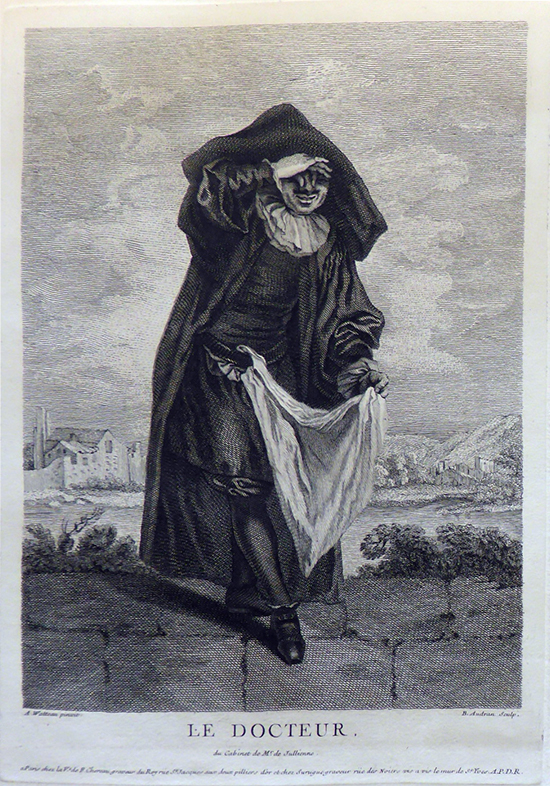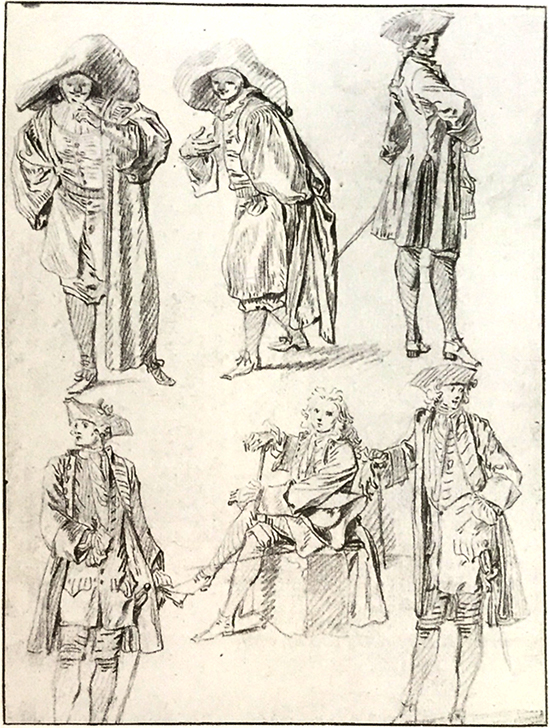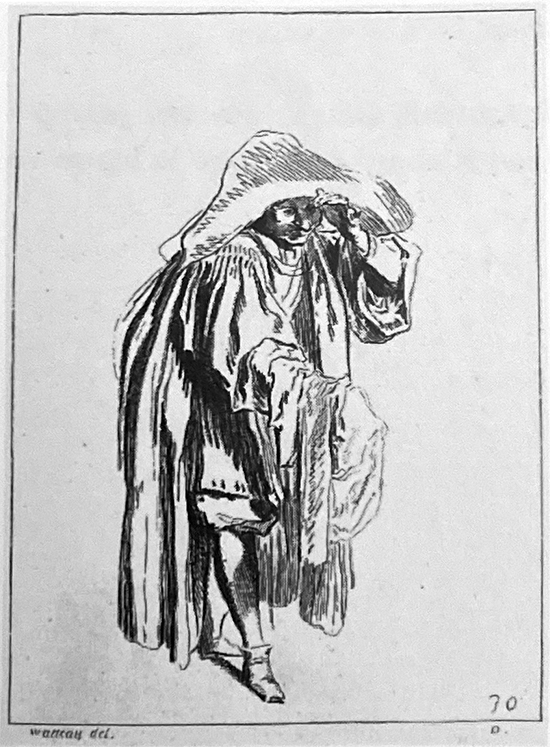
- Home Page
- Accepted
Paintings & Copies - Doubtful
Attributions - Doubtful Textual References
- Alternative
Titles - Collectors &
Museums - Bibliography
- Search Abecedario
- Watteau &
His Circle
Le Docteur
Entered February 2020

Presumed lost
Materials unknown
78.3 x 62.1 cm.
ALTERNATIVE TITLES
Docteur Baloir
Docteur Baloardo
Le Docteur, personnage de la comédie italienne
RELATED PRINTS

Bernard Audran after Watteau, Le Docteur, engraving.
Watteau’s Le Docteur was engraved in reverse by Bernard Audran.
PROVENANCE
Paris, with Jean de Jullienne (1686-1766; director of a tapestry factory). The caption on the engraving specifies “du Cabinet de Mr. Jullienne.”
Paris, anonymous sale, November 11, 1784; lot 36: “PAR LE MÊME [A. WATTEAU.] Un Paysage sur le devant duquel est une figure grotesque; derriere est un grand lac environné de maisons. Quoique peu capital, ce Tableau est agréable. Haut. 29 pouc. larg: 23 T.” Sold for 48 livres.
SELECT BIBLIOGRAPHY
Hédouin, “Watteau” (1845), cat. 42.
Hédouin, Mosaïque (1856), cat. 42.
Goncourt, L’Art au XVIIIème siècle (1860), 56.
Goncourt, Catalogue raisonné (1875), cat. 73.
Dacier, Vuaflart, and Hérold, Jean de Jullienne et les graveurs (1921-29), 2: 58, 67, 93, 97, 102, 121, 132; 3: cat.156.
Réau, “Watteau” (1928), cat. 59.
Adhémar, Watteau (1950), cat. 12.
Macchia and Montagni, L’opera completa di Watteau (1968), cat. 12.
Ferré, Watteau (1972), cat. B11.
Roland Michel, Watteau (1981), cat. 88.
Roland Michel, Watteau (1984), 156, 265-66, 269, 272.
Washington, Paris, Berlin, Watteau 1684-1721 (1984), 514.
Rosenberg and Prat, Watteau, Catalogue raisonné des dessins (1996), cat. G 9.
Costa de Beauregard, Journal de voyage (2013), 120 n. 463.
RELATED DRAWINGS

Watteau, Six Studies of Male Models, red chalk, 23.6 x 16.9 cm. Oxford, Ashmolean Museum.

Louis Desplaces after Watteau, Study of Dr. Baloardo, engraving, Figures de différents caractères, plate 30.
A number of Watteau’s early studies show the distinctively costumed actor, often in relation to paintings with theatrical subjects such as Harlequin, empereur dans la lune and Qu’ai je fait, assasins maudits. Occasionally studies of this actor appear among studies of models not in theatrical garb, as in a sheet in the Ashmolean Museum (Rosenberg and Prat 52). While four of the men are in daily dress, the two in the upper left are in Dr. Baloardo’s costume. Another study of this actor, now lost, is recorded in the Figures de différents caractères, plate 30. Here the actor’s pose—his hand to his hat, his other hand extended forward and holding a cloth, one foot extended as well—closely approaches that of the figure in the painting. Presumably, though, Watteau turned to yet another lost study when preparing his picture.
REMARKS
The histories of this painting and one that we have classified as Le Docteur Baloit de la comédie italienne have been conflated, as though they were one and the same picture. This was perhaps expectable since both depict the same commedia dell’arte character and both were in the collection of Jean de Jullienne. However, the Audran engraving shows that this version of Le Docteur was vertical in format, as was the painting sold in 1784. On the other hand, the painting of Dr. Baloardo cited in the 1756 Jullienne inventory and in the 1769 Gevigney sale was consistently described as horizontal in format and having larger dimensions. We have used the title Le Docteur Baloit de la comédie italienne for the second painting.
The composition of Le Docteur is a familiar formula in Watteau’s oeuvre: a vertical field with a single figure standing on the central axis, flanked at both sides by a distant landscape. Watteau employed this formula in works as diverse as La Fileuse, La Polonnaise debout, and L’Indifférent.Few scholars have discussed Le Docteur and fewer have tried to date it. Adhémar classified it among the artist’s earliest works, c. 1703-08; Macchia and Montagni chose 1705, Roland Michel proposed c. 1710. As always, there is little justification for these specific dates since the chronology of Watteau’s early paintings is essentially a house built on sand, with too few extant works and few fixed dates for any certainty.